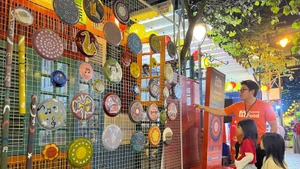For many years, the memorial site has fulfilled the cultural needs of people from all walks of life. By effectively promoting its value, the site can attract more visitors, making an important contribution to instilling patriotic traditions in the younger generation.
Honouring and remembering the Pho bang
Although he was born and raised in Nghe An, Cao Lanh became a land of deep affection for Nguyen Sinh Sac. When he settled in Hoa An Village, the local people cherished and cared for him like a family member. The residents admired his talent, virtue, and noble character as a patriotic Confucian scholar who loved and cared for the people. He passed away in the loving embrace of the Hoa An villagers on the night of October 26, early October 27, 1929.
Since the Nguyen Sinh Sac Memorial Site was completed, it has welcomed numerous visitors daily to pay their respects at his tomb and explore the memorial. Visitors express their profound admiration and gratitude for him. Nguyen Thi Hang, from Xuan Loc District, Dong Nai Province, shared: “This is my first time here, and I felt deeply moved as I lit incense to honour Nguyen Sinh Sac. Learning more about his life inspires young people to study harder to build successful futures and contribute to society.”
The site preserves various artefacts, documents, souvenirs, and even ancient trees, including a nearly 300-year-old starfruit tree donated by the locals. It also holds guestbooks filled with heartfelt messages from leaders and visitors. Each page reflects the deep respect and gratitude for Nguyen Sinh Sac.
One notable entry is from General Vo Nguyen Giap, written on March 8, 1991, “The Vietnamese people will forever remember Nguyen Sinh Sac, the patriotic Confucian scholar of Lam Hong land, who raised and educated the great President Ho Chi Minh, the nation’s outstanding son.”
According to the Nguyen Sinh Sac Memorial Site Management Board, after the country’s reunification, Dong Thap’s Party Committee, the government, and the people constructed the memorial site, which was inaugurated on February 13, 1977. The complex includes his tomb, a lotus-shaped monument, and exhibition halls displaying images and artefacts of Nguyen Sinh Sac’s life, as well as exhibits about President Ho Chi Minh’s life and career.
 |
| Visitors pay tribute to Nguyen Sinh Sac and tour the memorial site |
The construction process embodied the spirit of gratitude toward President Ho Chi Minh’s father. Over 18 months, between 200 and 700 people, including teachers, students, soldiers, and even elderly citizens, contributed labour to build the site.
While Nghe An’s Kim Lien, Nam Dan, takes pride in the hometown of a patriotic Confucian scholar, Cao Lanh honours the deep bonds and care it provided to Pho bang during his final years. Despite the challenges of wartime, local residents ensured the preservation of his tomb, organising annual commemorations with great devotion.
For years, the annual memorial day for Nguyen Sinh Sac has become a cherished cultural tradition in Dong Thap, featuring rituals and community activities, such as making traditional banh tet (cylindrical sticky rice cake) to serve the ceremonies.
Aiming for national special relic status
The Nguyen Sinh Sac Memorial Site spans nearly 9 hectares. It is divided into four main areas: the tomb, memorial temple, exhibition halls on Nguyen Sinh Sac and President Ho Chi Minh’s lives, and a cultural space recreating Hoa An Village. It also features Ho Chi Minh’s stilt house, a pond, and gardens, as well as a space for traditional games and recreational activities. The site is a harmonious architectural complex, rich in historical and cultural significance.
In 2010, the site launched a preservation project to restore and enhance its value. The project reconstructed elements of Hoa An Village, allowing visitors to experience the environment where Nguyen Sinh Sac lived from 1927 to 1929.
As one of Dong Thap’s premier tourist destinations, the site serves as an important venue for historical education and patriotic inspiration. Dong Thap proudly represents the nation in safeguarding Nguyen Sinh Sac’s tomb and legacy.
Over time, some areas of the site have deteriorated, necessitating restoration. To further preserve and promote its historical and cultural significance, Dong Thap’s Department of Culture, Sports, and Tourism is implementing a project (2024–2026) to restore the site and submit a proposal to recognise it as a National Special Relic.
According to the department’s director, Huynh Thi Hoai Thu, the project aims to enhance the site’s architecture, infrastructure, and cultural activities. It will provide visitors with opportunities for learning, relaxation, and experiencing local specialities and the unique art forms of Southern Vietnam.
Dong Thap will continue highlighting the memorial’s historical and cultural value through meaningful activities. The province will strengthen collaborations between schools and the site to organise students' extracurricular programmes, fostering national pride and a sense of responsibility in preserving local cultural heritage.
















